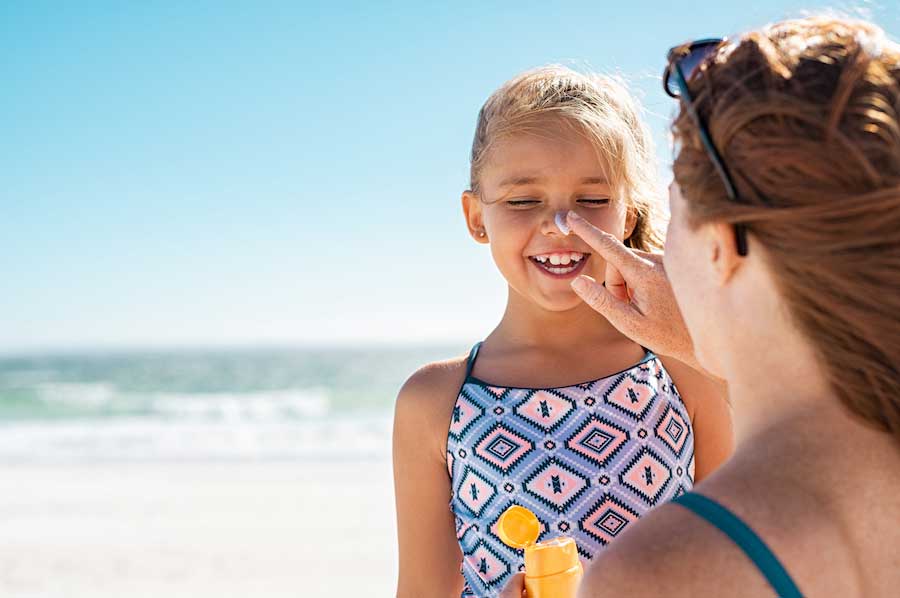Are you dealing with painful, unsightly or annoying warts? Some warts disappear on their own, but it can take months or years. Luckily, treatments like cryotherapy — freezing the wart by applying liquid nitrogen — can help the wart go away faster.1
Keep reading to learn more about warts and how cryotherapy can help remove them.
What Are Warts?
Warts are noncancerous growths on the upper layer of the skin. They are typically skin-colored, raised and rough, though they can also be darker-colored, flat and smooth. Most warts are painless, but some can be itchy and painful — particularly if they're on your feet. Warts can appear on all parts of the body.1
Causes
Warts are caused by viruses in the human papillomavirus (HPV) family. When skin cells are infected with HPV, they grow faster than normal, causing warts. Wart viruses are contagious and can spread through skin-to-skin contact between two people and from one place on your body to another. It's easier to get warts when you have a cut or scrape on your skin or in an area where you shave.1
Types
There are several different types of warts:1
- Common warts. These typically feel like rough bumps, and they grow on the fingers, around the nails and on the backs of the hands.
- Filiform warts. Some of the most bothersome because of their features and location, these spiky, threadlike warts are most commonly found on the face.
- Flat warts. These smooth, small warts can appear anywhere. They're most often found on the face, forehead or cheeks but can also appear on the lower limbs and hands.
- Genital warts. These appear on the genitals, in the pubic area and between the thighs. Genital warts are very contagious.
- Plantar warts. These typically appear on the soles of the feet, and they can grow in clusters. Plantar warts can be painful.
Who Can Get Warts?
While warts are very common, some people are more prone to getting them than others, including:1
- Children and teenagers
- People with atopic skin diseases like eczema
- People with a weakened immune system
- Those who work with raw chicken, meat or fish
Most people have frequent contact with HPV, but only some develop warts.2
Why Treat Warts?
About half of warts go away on their own within a year and two-thirds go away within two years, but treating warts can help get rid of them more quickly.2
Treating warts immediately may reduce the amount of virus shed into nearby tissue and potentially lower the chance of recurrence.2
What Is Cryotherapy for Warts?
Cryotherapy (aka cryosurgery) for warts involves freezing the skin growths. During cryotherapy, dermatologists use cryogens (freezing agents) like liquid nitrogen to target and destroy warts. With a temperature of -321 degrees Fahrenheit (-196 degrees Celsius), liquid nitrogen allows doctors to freeze and remove warts without cutting into the skin.2
If over-the-counter treatments like salicylic acid haven't been successful — or you just want to quickly treat your warts — cryotherapy may be an option to consider.2
Cryotherapy benefits
There are several advantages to treating warts with cryotherapy. Typically, this treatment is:3
- Affordable. Cryotherapy is relatively inexpensive.
- Effective. Cryotherapy is known for its high success rate for wart removal.
- Minimally invasive. Unlike surgical procedures, cryosurgery does not involve anesthesia or cutting into the skin.
- Quick. This treatment typically takes just a few minutes in your doctor's office.
- Safe. For most healthy people, liquid nitrogen-based wart removal is considered safe.
Cryotherapy side effects
Though cryotherapy complications are rare, they may include:4
- Blistering
- Permanent changes in skin color
- Scarring
- Temporary nerve damage near the treatment area
- Tenderness or pain
Limitations of Cryotherapy for Warts
Cryotherapy does not treat the HPV infection that causes warts; it treats the warts themselves. Since there is no cure for the wart virus, warts can return in the same spot or elsewhere.5
Sometimes, old warts shed virus cells into the skin before treatment, and new warts grow around the old ones. To prevent continual recurrence, ask your dermatologist to treat new warts as soon as you see them.5
What to Expect During Cryotherapy for Warts
Wart removal with cryotherapy may include the following steps:4
- Application of a local anesthetic to numb the wart
- A scalpel or file to remove dead skin cells off the wart to allow the liquid nitrogen to penetrate deeper
- A cotton swab, probe or spray to apply liquid nitrogen to the wart
- Reapplication of liquid nitrogen if tolerated and needed
The whole process typically takes just a few minutes in your doctor's office.4 You may feel minor pain during the freezing and a burning sensation when the skin thaws.1 This discomfort may be decreased by applying a local anesthetic beforehand.4
Note that you may need up to four cryotherapy treatments, one to three weeks apart, to completely remove a wart.4 If these sessions are unsuccessful, your doctor may recommend another type of wart removal.2
Recovery From Cryotherapy for Warts
Soon after the cryotherapy procedure, the treated area may become sensitive, red and swollen.1
Within about 24 hours, a blister may form around the wart. Don't break the blister. If the blister breaks on its own, clean the fluid carefully with an antiseptic wipe to minimize viral spread. The blister should dry up over the next few days, and the wart may fall off.4
It takes about seven to 14 days for the skin to heal after cryotherapy.4 For genital warts, however, healing takes about one to three weeks.6
Note that cryotherapy can cause hair loss in the impacted area, depending on the intensity of the treatment. This hair loss can be permanent. Skin discoloration of the treated area may also persist for up to a year after the procedure, with some individuals having lasting pigmentation changes.7
Cryotherapy Aftercare Instructions
Gently wash the treated area with unscented soap and water once or twice a day. To avoid irritation and help the skin heal, apply petroleum jelly to the treated area every day for two weeks. Leave the area uncovered unless there's drainage or it's rubbing against clothing. Once the area has healed, apply an SPF 30+ sunscreen for protection against scarring.7
If you had cryotherapy for genital warts, it's best to avoid sexual contact until the treated area heals.6
How Much Does Cryotherapy Treatment for Warts Cost?
The national average cost* of cryotherapy for wart removal is $226, but the cost ranges between $175 and $443, depending on factors such as the size and number of warts as well as the number of required treatment sessions.8
Average cost of cryotherapy for warts by state/district
Below is a breakdown of the average cost* of cryotherapy to remove warts across all 50 states and the District of Columbia.8
| State/District | Average cost |
|---|---|
| Alabama | $193 |
| Alaska | $275 |
| Arizona | $228 |
| Arkansas | $195 |
| California | $278 |
| Colorado | $229 |
| Connecticut | $235 |
| Delaware | $226 |
| District of Columbia | $326 |
| Florida | $226 |
| Georgia | $204 |
| Hawaii | $332 |
| Idaho | $229 |
| Illinois | $214 |
| Indiana | $207 |
| Iowa | $197 |
| Kansas | $201 |
| Kentucky | $210 |
| Louisiana | $212 |
| Maine | $228 |
| Maryland | $253 |
| Massachusetts | $265 |
| Michigan | $207 |
| Minnesota | $216 |
| Mississippi | $188 |
| Missouri | $200 |
| Montana | $224 |
| Nebraska | $204 |
| Nevada | $223 |
| New Hampshire | $231 |
| New Jersey | $264 |
| New Mexico | $206 |
| New York | $240 |
| North Carolina | $210 |
| North Dakota | $207 |
| Ohio | $205 |
| Oklahoma | $194 |
| Oregon | $248 |
| Pennsylvania | $220 |
| Rhode Island | $233 |
| South Carolina | $206 |
| South Dakota | $204 |
| Tennessee | $201 |
| Texas | $209 |
| Utah | $227 |
| Vermont | $238 |
| Virginia | $220 |
| Washington | $254 |
| West Virginia | $201 |
| Wisconsin | $213 |
| Wyoming | $211 |
Insurance for cryotherapy
When cryotherapy is deemed medically necessary, it may be covered by insurance.9 Wart removal may be medically necessary to treat pain or infection or to reduce the likelihood of cancer or other serious health conditions.10 Cryotherapy for cosmetic purposes is typically not covered by insurance.10
Cost-saving alternatives
Home-based cryotherapy can be a cost-saving alternative to in-office cryotherapy.11 Keep in mind, though, that over-the-counter wart-freezing products may be less powerful.12 Because of this, home-based freezing products may be able to remove small warts but only temporarily reduce the size or appearance of larger warts.12
Always talk to your doctor before attempting to remove a facial wart at home, and never try to treat genital warts at home — these must be treated by a doctor.12
Additional Alternative Treatments for Warts
Aside from cryotherapy, there are other wart treatment options to consider:5
- Cantharidin. This in-office treatment involves painting the chemical cantharidin on warts, which causes a blister to form beneath them. In a week or so, your doctor will slough off the dead warts.
- Chemical peels. Chemical peels with high-potency salicylic acid, tretinoin or glycolic acid may be prescribed for at-home treatment.
- Electrosurgery and curettage. This treatment method combines using intense heat to burn the wart along with scraping off the dead skin.
- Excision. This procedure involves cutting out the wart.
- Laser treatments. Laser treatments for warts may be suggested as an option for warts that have not responded to other treatments.
Talk to your dermatologist to see if cryotherapy or one of these wart treatments is right for you.
Financing Cryotherapy for Warts With the CareCredit Credit Card
When getting cryotherapy for wart removal or another cosmetic procedure, the CareCredit credit card can help you pay for costs not covered by insurance.** Use our Acceptance Locator to find a doctor or cosmetic specialist near you that accepts CareCredit. Continue your wellness journey by downloading the CareCredit Mobile App to manage your CareCredit account, find a provider on the go and easily access the Well U blog for more great articles, podcasts and videos.
In addition to cosmetic procedures, you can also use your CareCredit credit card for dentistry, pet care, vision, hearing, health systems, dermatology, pharmacy purchases, spa treatments and so much more within the CareCredit network. How will you invest in your health and wellness next?
Author Bio
Kate Bayless is a health and wellness freelance writer with 15 years of experience. Her work has appeared in Parents, Women's Health, Beachbody and OpenFit.







